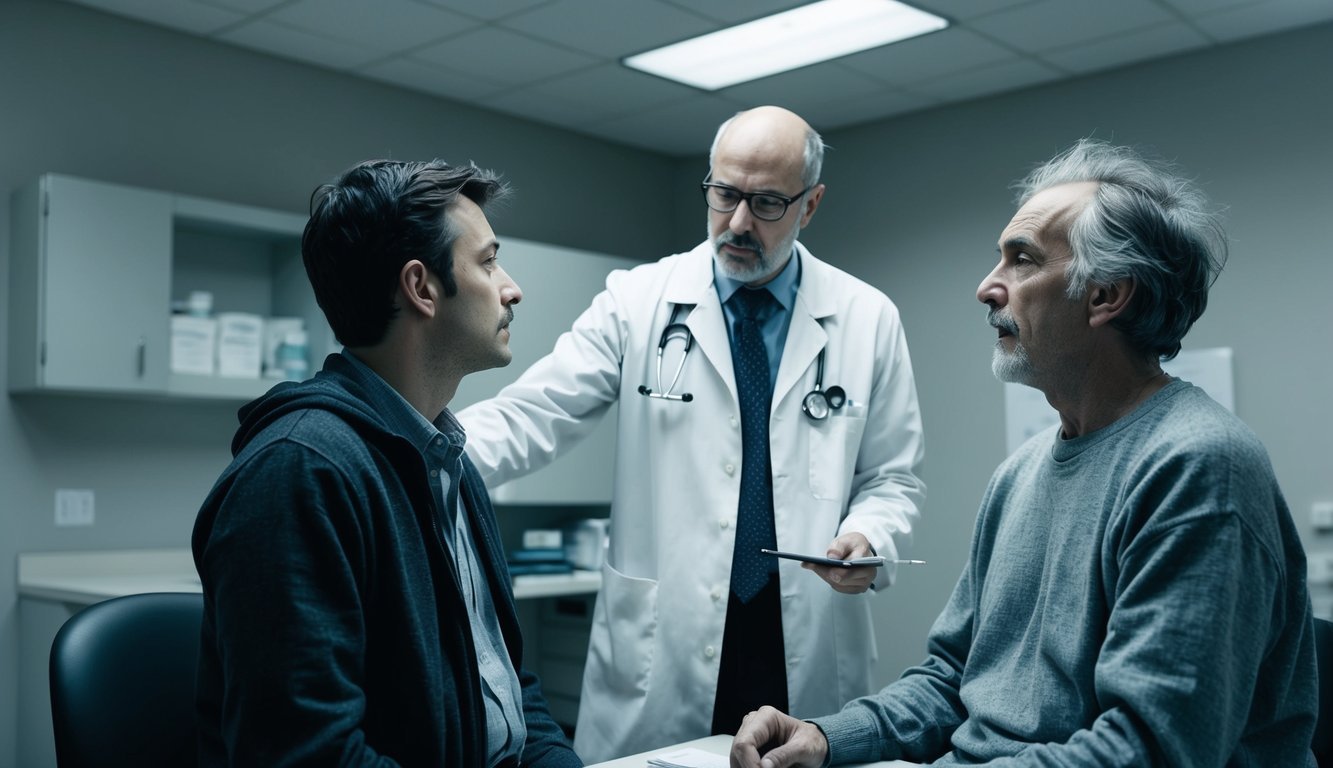PsychNewsDaily Publishers
100 Summit Drive
Burlington, MA, 01803
Telephone: (320) 349-2484
PsychNewsDaily Publishers
100 Summit Drive
Burlington, MA, 01803
Telephone: (320) 349-2484
Psychotic disorders involve altered perceptions of reality, characterized by hallucinations, delusions, and disorganized thinking, significantly impacting communication, relationships, and daily functioning.

Psychotic disorders represent various mental health issues characterized by altered perceptions of reality. These disorders profoundly affect an individual’s thoughts, emotions, and actions, often resulting in challenges in everyday functioning.
Psychotic disorders are marked by a disconnection from reality, typically evident through hallucinations, delusions, or disorganized thinking. Hallucinations involve sensory perceptions, such as hearing voices or seeing things that don’t exist. Delusions, on the other hand, are persistent false beliefs held despite contrary evidence.
Such disorders can hinder a person’s ability to communicate effectively, make sound decisions, and nurture relationships. Psychotic symptoms often emerge in late adolescence or early adulthood, although they can begin at any stage of life.
Diagnosing these disorders necessitates a thorough assessment by mental health professionals, who evaluate the symptoms’ duration, severity, and their effects on daily living.
There are several unique psychotic disorders, each with specific traits:
Schizophrenia: This is the most prevalent psychotic disorder, characterized by chronic symptoms that persist for a minimum of six months.
Brief psychotic disorder: Involves temporary episodes of psychotic behavior, typically triggered by intense stress.
Schizoaffective disorder: A combination of schizophrenia features and mood disorder symptoms.
Delusional disorder: Characterized by non-bizarre delusions lasting for at least one month.
Substance-induced psychotic disorder: Arises from the effects of drugs or alcohol.
These disorders differ in their duration, severity, and specific symptoms. Treatment usually involves a combination of antipsychotic medications, psychotherapy, and social support aimed at managing symptoms and enhancing quality of life.

The onset of psychotic disorders results from complex interactions between genetic, environmental, and neurobiological factors, influencing the development and progression of conditions such as schizophrenia.
Genetic factors significantly contribute to the onset of psychotic disorders. Studies show a heightened risk for those with family members who have these disorders. Research on twins indicates greater concordance rates among monozygotic twins than dizygotic twins.
Particular genes, including DISC1, COMT, and NRG1, are linked to a greater vulnerability to these disorders by affecting neurotransmitter balance and brain development. Polygenic risk scores can help determine an individual’s genetic predisposition.
Epigenetic changes, which affect gene expression without altering the DNA sequence, also play a role in risk. Environmental influences can trigger these changes, illustrating the genetic-environment interaction.
Numerous environmental factors can heighten the risk of developing psychotic disorders. Complications during pregnancy, such as maternal stress, infections, and nutritional deficits, can adversely affect fetal brain development.
Childhood trauma, including abuse and neglect, is associated with an increased likelihood of psychotic symptoms. High-density living environments and immigration status correlate with elevated rates of such disorders, potentially due to social stresses or environmental toxins.
Substance use, particularly cannabis and stimulants, can provoke psychotic episodes in those at risk. Additionally, persistent stress and social isolation can initiate or worsen symptoms.
Exposure to infectious agents, such as Toxoplasma gondii, has also been linked to some schizophrenia cases.
Abnormalities in brain structure and function are commonly found in individuals with psychotic disorders. Neuroimaging studies have identified reductions in gray matter in areas like the prefrontal cortex and hippocampus.
Imbalances in neurotransmitters are significant contributors, with the dopamine hypothesis suggesting excessive dopaminergic activity in certain brain regions. Dysregulation of glutamate and GABA also plays a role in the manifestation of symptoms.
Neuroinflammation and oxidative stress are thought to contribute to the pathology of psychotic disorders by causing neuronal damage and changing brain connectivity.
Disruptions in neural circuits, particularly within the default mode and salience networks, are linked to psychotic symptoms, influencing cognitive functioning and information processing.

Psychotic disorders can present through a variety of distinctive signs and symptoms. Comprehensive evaluation and accurate diagnosis are essential for successful treatment and management.
Common features of psychotic disorders include hallucinations, which are sensory experiences triggered without any external stimuli. Typical examples include auditory hallucinations (e.g., hearing voices) and visual hallucinations (e.g., seeing nonexistent objects). Delusions, or firmly held false beliefs despite contradictory evidence, are another hallmark symptom.
Disorganized thinking is frequently noted, exhibiting as incoherent speech or illogical thought processes. Negative symptoms, which may present as a lack of emotional expression or reduced motivation, can also occur. These may include:
Diagnosing psychotic disorders involves a thorough evaluation by mental health professionals. The diagnostic process generally includes:
The Diagnostic and Statistical Manual of Mental Disorders (DSM-5) outlines criteria for diagnosing different psychotic disorders. Clinicians assess symptom duration, intensity, and their effects on functioning while considering family history and possible substance use.
Differential diagnosis is vital, as psychotic symptoms may overlap with those of other psychiatric conditions. Early identification and intervention are critical for better outcomes in psychotic disorders.

Successful management of psychotic disorders relies on a blend of pharmacological treatment and psychosocial support. These methods work together to alleviate symptoms, enhance functioning, and improve the overall quality of life for individuals with psychosis.
Antipsychotic medications are fundamental in managing psychosis. Both first-generation (typical) and second-generation (atypical) antipsychotics focus on dopamine receptors to alleviate positive symptoms such as hallucinations and delusions. Atypical antipsychotics may also alleviate negative symptoms and improve cognitive deficits.
Medication management is essential, with careful dosage adjustments to balance side effects and maximize therapeutic impact. Routine monitoring of blood levels, metabolic indicators, and possible adverse effects is also crucial.
Supplementary medications may be prescribed to target specific symptoms or coexisting conditions, which may include mood stabilizers, antidepressants, or anxiolytics.
Cognitive-behavioral therapy (CBT) is an evidence-based intervention for individuals with psychotic disorders. It assists individuals in challenging delusional beliefs, developing coping strategies, and enhancing social interactions.
Interventions focused on family education can foster understanding of the disorder and improve communication between family members. This support may lead to reduced relapse rates and better adherence to treatment.
Team-based care models, known as coordinated specialty care, offer comprehensive treatment that combines medication, therapy, case management, and vocational support.
Training in social skills and vocational rehabilitation assist individuals in reintegrating into society. Group therapy sessions provide support from peers and practice for interpersonal skills.
Psychodynamic therapy may also be beneficial in exploring underlying psychological conflicts that contribute to psychotic symptoms in some individuals.

Living with a psychotic disorder poses specific challenges in daily life and interactions. Effective coping strategies and robust support systems are critical for enhancing the quality of life for those affected.
People with psychotic disorders may struggle to maintain routines and handle daily responsibilities. Memory issues can disrupt daily tasks. Creating structured schedules and utilizing reminders can assist in managing appointments and medications.
Regular physical activity and a balanced diet are vital for overall well-being. Techniques for stress management, such as mindfulness and deep breathing, can alleviate symptom severity.
Collaborating with mental health professionals is essential in developing tailored coping strategies. This process might include recognizing triggers and early warning signs of psychotic incidents.
Tackling co-occurring conditions, such as substance use disorders or PTSD, is essential for comprehensive treatment. Regular health check-ups can help detect physical health issues, as individuals with psychotic disorders may have an increased risk of problems like strokes.
Those dealing with psychotic disorders require a strong support network. Friends and family play a vital role in offering emotional and practical assistance.
Support groups allow individuals to connect with others facing similar challenges.
Mental health professionals, including psychiatrists and therapists, provide core clinical support, ensuring ongoing treatment, medication management, and therapeutic interventions.
Community resources, such as vocational training and housing assistance programs, can significantly enhance social functioning and independence. Additionally, peer support specialists, who draw from their personal experiences with mental health issues, can provide valuable insights and motivation.
In crisis situations, having a safety plan that includes emergency contacts and resources for handling suicidal thoughts is essential. New mothers experiencing postpartum psychosis require specialized support for themselves and their families.
“`